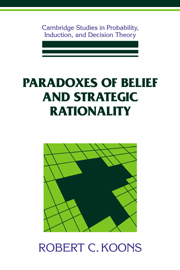Book contents
- Frontmatter
- Contents
- Preface
- Introduction
- Part I Paradoxes
- Part II Solutions
- 5 A critique of context-insensitive solutions to the liar paradox
- 6 Three context-sensitive solutions to the liar paradox
- 7 Applying the context-sensitive solutions to doxic paradox
- Conclusion
- Appendix A Applying probability to mathematical sentences
- Appendix B Proofs of Theorems 2 and 3 from Chapter 6
- Appendix C On schematic generalization
- Bibliography
- Index
5 - A critique of context-insensitive solutions to the liar paradox
Published online by Cambridge University Press: 06 January 2010
- Frontmatter
- Contents
- Preface
- Introduction
- Part I Paradoxes
- Part II Solutions
- 5 A critique of context-insensitive solutions to the liar paradox
- 6 Three context-sensitive solutions to the liar paradox
- 7 Applying the context-sensitive solutions to doxic paradox
- Conclusion
- Appendix A Applying probability to mathematical sentences
- Appendix B Proofs of Theorems 2 and 3 from Chapter 6
- Appendix C On schematic generalization
- Bibliography
- Index
Summary
I will discuss five families of proposals for dealing with the paradox of the liar. Each of these five has a counterpart that could be proposed as a solution to the paradox of the disprover (discussed in Part I). In some cases, the proposed solutions to the liar incur the very same advantages and disadvantages when applied to the disprover, in such cases, the disprover is of relatively little interest. In many cases, however, proposals that are quite plausible and feasible when applied to the liar suffer collapse or encounter major new difficulties when applied to the disprover; it is in these cases that the paradox of the disprover holds the most promise of new insights.
The five families of approaches to solving the liar as it appears in natural language are as follows:
(1) Insist that significant semantic self-reference is impossible.
(2) Maintain a dichotomy between the metalanguage in which the theory is cast and the natural language that is the object of study.
(3) Maintain a distinction between denying a sentence and asserting its negation.
(4) Weaken the axioms or the logic used to derive the contradiction.
(5) Treat sentence tokens, rather than sentence types, as the bearers of truth and falsity.
I do not include the Tarskian object language–metalanguage distinction as a proposed solution to the liar as it occurs in natural language. Tarski was interested only in developing a consistent and adequate theory of truth for formal languages.
- Type
- Chapter
- Information
- Paradoxes of Belief and Strategic Rationality , pp. 85 - 97Publisher: Cambridge University PressPrint publication year: 1992

